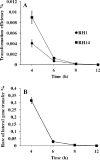Fratricide is essential for efficient gene transfer between pneumococci in biofilms
- PMID: 22706053
- PMCID: PMC3406168
- DOI: 10.1128/AEM.01343-12
Fratricide is essential for efficient gene transfer between pneumococci in biofilms
Abstract
Streptococcus pneumoniae and a number of commensal streptococcal species are competent for natural genetic transformation. The natural habitat of these bacteria is multispecies biofilms in the human oral cavity and nasopharynx. Studies investigating lateral transfer of virulence and antibiotic resistance determinants among streptococci have shown that interspecies as well as intraspecies gene exchange takes place in these environments. We have previously shown that the action of a competence-specific murein hydrolase termed CbpD strongly increases the rate of gene transfer between pneumococci grown in liquid cultures. CbpD is the key component of a bacteriolytic mechanism termed the fratricide mechanism. It is secreted by competent pneumococci and mediates the release of donor DNA from sensitive streptococci present in the same environment. However, in nature, gene exchange between streptococci takes place in biofilms and not in liquid cultures. In the present study, we therefore investigated whether CbpD affects the rate of gene transfer in laboratory-grown biofilms. Our results show that the fratricide mechanism has a strong positive impact on intrabiofilm gene exchange, indicating that it is important for active acquisition of homologous donor DNA under natural conditions. Furthermore, we found that competent biofilm cells of S. pneumoniae acquire a Nov(r) marker much more efficiently from neighboring cells than from the growth medium. Efficient lysis of target cells requires that CbpD act in conjunction with the murein hydrolase LytC. In contrast, the major autolysin LytA does not seem to be important for fratricide-mediated gene exchange in a biofilm environment.
Figures





Similar articles
-
Fratricide in Streptococcus pneumoniae: contributions and role of the cell wall hydrolases CbpD, LytA and LytC.Microbiology (Reading). 2009 Jul;155(Pt 7):2223-2234. doi: 10.1099/mic.0.026328-0. Epub 2009 Apr 23. Microbiology (Reading). 2009. PMID: 19389766
-
The pneumococcal cell envelope stress-sensing system LiaFSR is activated by murein hydrolases and lipid II-interacting antibiotics.J Bacteriol. 2010 Apr;192(7):1761-73. doi: 10.1128/JB.01489-09. Epub 2010 Jan 29. J Bacteriol. 2010. PMID: 20118250 Free PMC article.
-
LytF, a novel competence-regulated murein hydrolase in the genus Streptococcus.J Bacteriol. 2012 Feb;194(3):627-35. doi: 10.1128/JB.06273-11. Epub 2011 Nov 28. J Bacteriol. 2012. PMID: 22123253 Free PMC article.
-
Competence in Streptococcus pneumoniae and Close Commensal Relatives: Mechanisms and Implications.Front Cell Infect Microbiol. 2019 Apr 3;9:94. doi: 10.3389/fcimb.2019.00094. eCollection 2019. Front Cell Infect Microbiol. 2019. PMID: 31001492 Free PMC article. Review.
-
Competence-induced fratricide in streptococci.Mol Microbiol. 2007 Jun;64(6):1423-33. doi: 10.1111/j.1365-2958.2007.05757.x. Mol Microbiol. 2007. PMID: 17555432 Review.
Cited by
-
Mechanism of Action of Ribosomally Synthesized and Post-Translationally Modified Peptides.Chem Rev. 2022 Sep 28;122(18):14722-14814. doi: 10.1021/acs.chemrev.2c00210. Epub 2022 Sep 1. Chem Rev. 2022. PMID: 36049139 Free PMC article. Review.
-
A Mechanism of Unidirectional Transformation, Leading to Antibiotic Resistance, Occurs within Nasopharyngeal Pneumococcal Biofilm Consortia.mBio. 2018 May 15;9(3):e00561-18. doi: 10.1128/mBio.00561-18. mBio. 2018. PMID: 29764945 Free PMC article.
-
Novel role for the Streptococcus pneumoniae toxin pneumolysin in the assembly of biofilms.mBio. 2013 Sep 10;4(5):e00655-13. doi: 10.1128/mBio.00655-13. mBio. 2013. PMID: 24023386 Free PMC article.
-
Comment on: "Prevalence, Antibiotic Susceptibility Profile and Associated Factors of Group A Streptococcal Pharyngitis Among Pediatric Patients with Acute Pharyngitis in Gondar, Northwest Ethiopia" [Letter].Infect Drug Resist. 2023 May 8;16:2783-2785. doi: 10.2147/IDR.S418143. eCollection 2023. Infect Drug Resist. 2023. PMID: 37187485 Free PMC article. No abstract available.
-
Dense genomic sampling identifies highways of pneumococcal recombination.Nat Genet. 2014 Mar;46(3):305-309. doi: 10.1038/ng.2895. Epub 2014 Feb 9. Nat Genet. 2014. PMID: 24509479 Free PMC article.
References
-
- Bateman A, Rawlings ND. 2003. The CHAP domain: a large family of amidases including GSP amidase and peptidoglycan hydrolases. Trends Biochem. Sci. 28:234–237 - PubMed
-
- Chi F, Nolte O, Bergmann C, Ip M, Hakenbeck R. 2007. Crossing the barrier: evolution and spread of a major class of mosaic pbp2x in Streptococcus pneumoniae, S. mitis and S. oralis. Int. J. Med. Microbiol. 297:503–512 - PubMed
-
- Claverys JP, Håvarstein LS. 2007. Cannibalism and fratricide: mechanisms and the raisons d'être. Nat. Rev. Microbiol. 5:219–229 - PubMed
Publication types
MeSH terms
Substances
LinkOut - more resources
Full Text Sources
Molecular Biology Databases

